T&C material - Persian war and cultural identities
1/21
There's no tags or description
Looks like no tags are added yet.
Name | Mastery | Learn | Test | Matching | Spaced |
|---|
No study sessions yet.
22 Terms
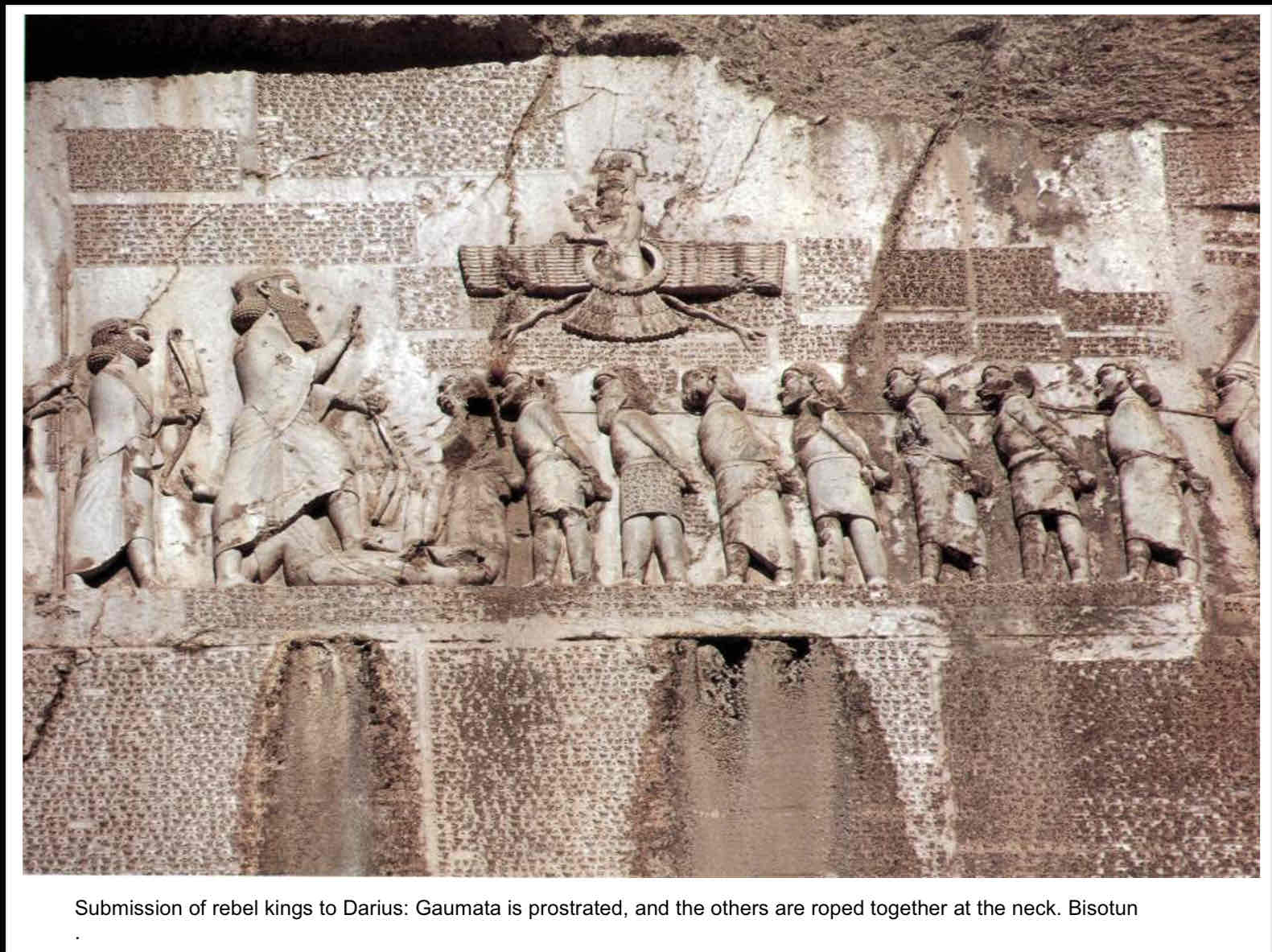
Bisitun, Darius’ rock relief
520-19BC, Bisotun, still there (along Royal road from Sardis to Susa)
Shows Persian king Darius before 10 ‘lying kings’ (with hands tied behind and connected by rope around their necks = explicit suppression)
Has bow! Sign of royalty (+ large beard attached as separate block of stone = significance of large beard)
All kings are named with small inscriptions - why?
+ all kings individualised by their clothing eg. Skunka has pointed hat (success across empire)
Stepping on Gaumata before him, as he lifts his hand (in thanks / greeting?) to Ahura mazda who floats above the prisoners = brought them to him?
Much larger than the prisoners and even his guards
This relief was placed up = stop defacing of message? (to the gods, not for people?)
But has writing in three different languages - Old Persian, Elamite and Babylonian
Paradox of accessibility
Also perhaps because mountains were seen as sacred = ‘place where the gods dwell’ = for divinity? At least adds divine element
Post-revolt statement to cement his own power (common response of coup ruler - see Nereid monument)
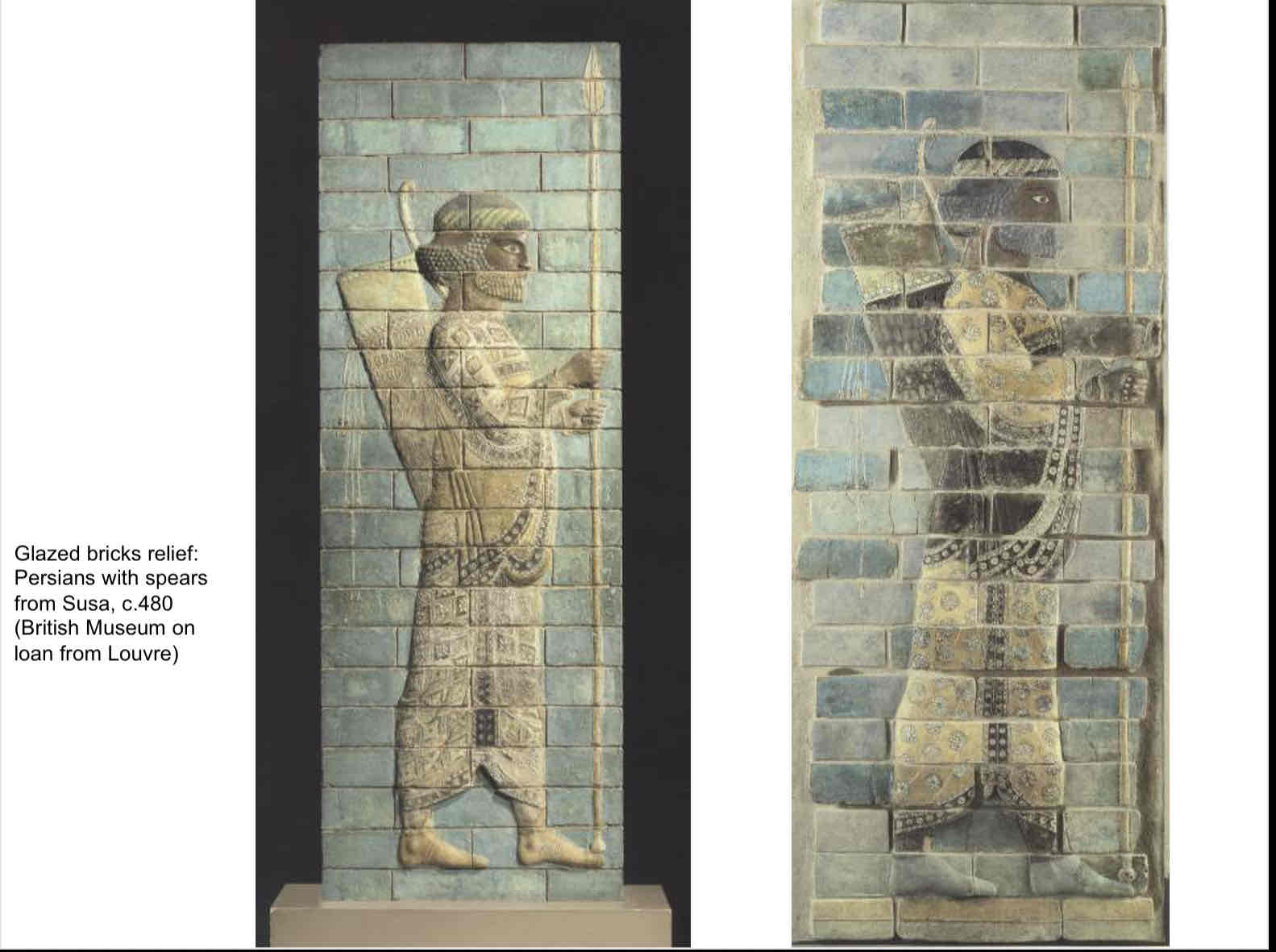
Susa glazed brick reliefs, guards
480BC, Susa, British museum on loan from Louvre
Glazed brick - goes back to Elamite temple of Chogha Zanbil 13th BC
Portrayal of a Persian ‘immortal’ = ideal warrior (found in the apadana at Susa, built by Darius)
Part of larger frieze representing rows of guards (similar to the guards that stand behind Darius!)
Susa was where Greek diplomats met the king = would have known that they use range of weaponry but emphasise archery (portrayal as weak man like Paris)
Side-profile, in walking pose = quite similar to Greek stelai!
Have a spear like Greek warriors, and also a bow (not only weapon)
+ have patterned costume, but not a jumpsuit (more like long-sleeve dress down to ankles)
Bright colours (yellow etc.)
Has beard like Greek portrayals but much more schematically rendered (like hair - snailcurls)
Angular faces with forehead transitioning into nose imperceptibly (skin painted dark)
No expression conveyed = not in action, not doing anything, just a representation of the ideal Persian warrior (might also be for intimidation purposes = show the power of Persia)
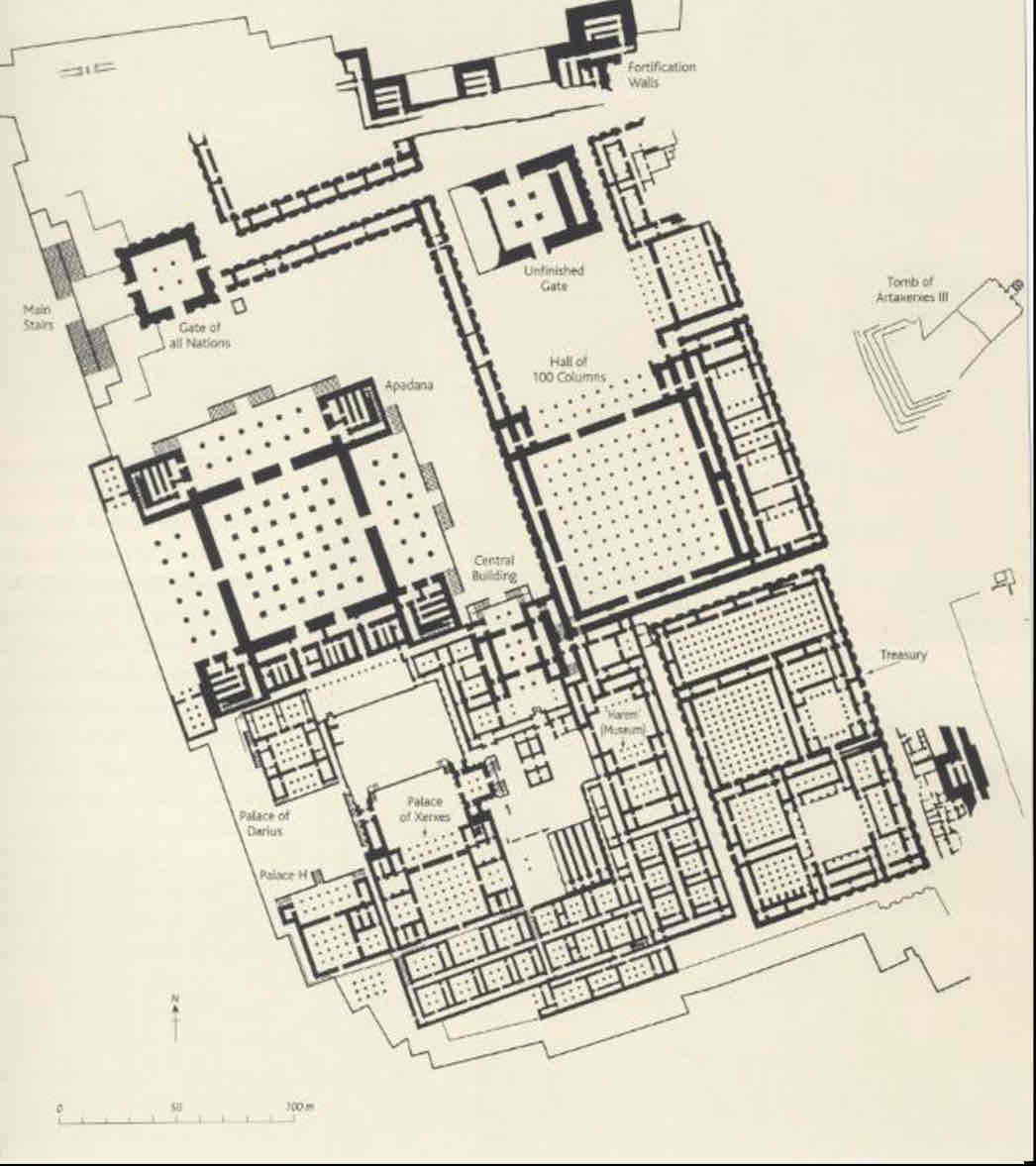
Persepolis apadana map
1st half of 6th century, Persepolis Iran
450×300m (Acropolis is 300x125m!)
Ceremonial rather than urban (a symbolic capital)
Enter the palace of Persepolis through the Gate of All Nations
But have to go up main stairs to even reach this = all above you (closer to divine? but also emphasise superiority)
21m tall
Has Lamassu on either side (winged bulls with lion legs and human face) which were associated with divinity
Wings in Persian culture / bulls in Babylonian culture
Held an apotropaic function here (= those entering were already intimidated)
Then go through corridor (unfinished army road) between rows of high columns = all done to make you feel small
And show the wealth of the empire (room of 100 columns = how many they could have)
Also create sense of succinctness = all have columns (nothing is different, but one rule that remains the same = sense of imperial stability)
Then to see the king, have to enter up the stairs of the apadana where you see the relief tribute-bearers
Apadana had unique feature - open (columned) verandas on 3 sides
Columns were more Greek than Assyrian or Egyptian (influence of Ionic taking over from Doric BUT closer flutes)
All built by paid workers (slavery was forbidden by Zoroastrianism)
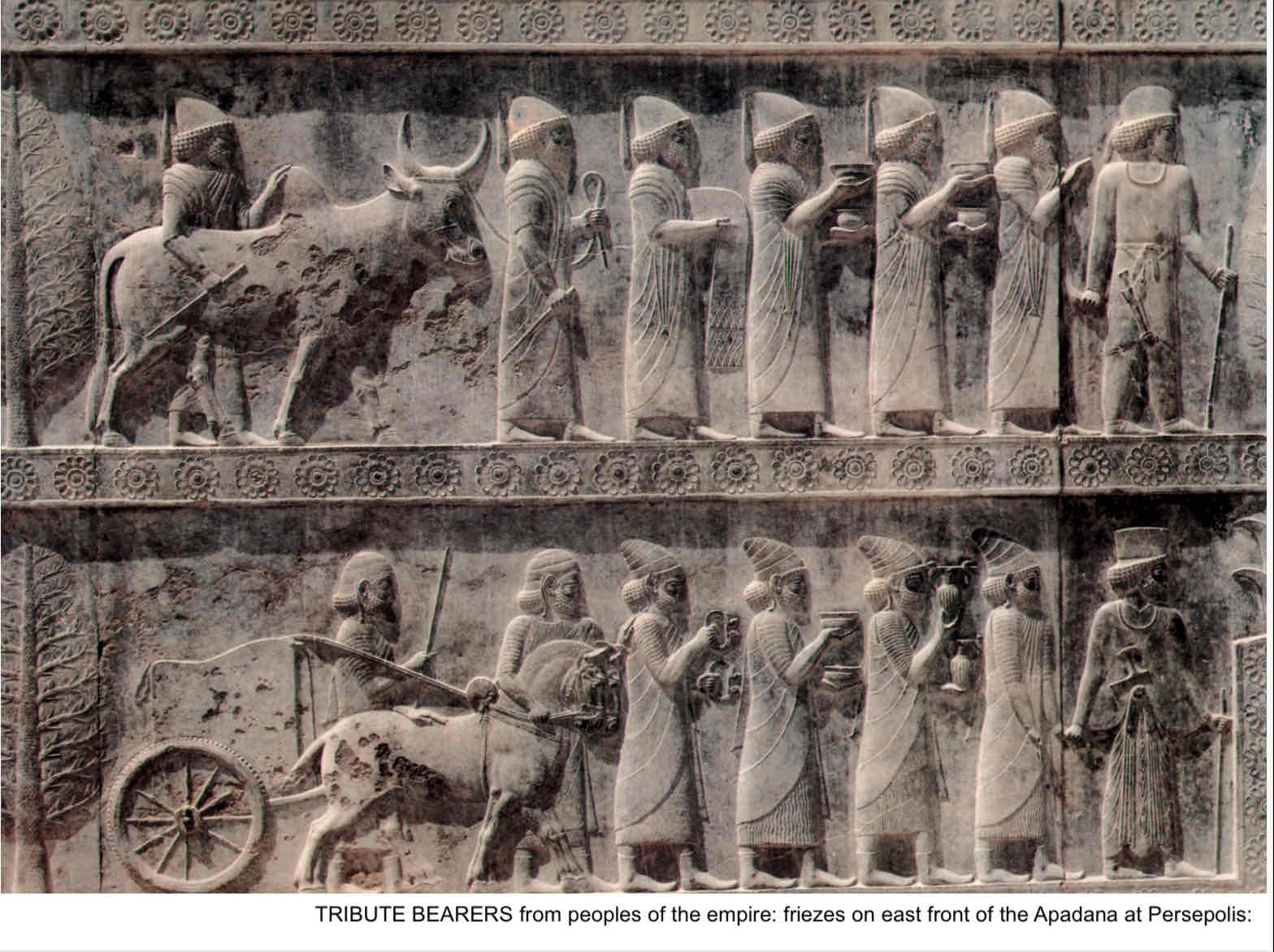
Persepolis apadana relief
1st half of 6th century, Persepolis Iran
Very low relief
Tribute-bearers would follow you as you walked up to see the king yourself
= reminder of your position (even if not there to carry tribute = will always be in inferior position to king)
The ones shown here are the Babylonians (conical caps with tassles) - Herod says they give a large tribute (enough for 1/3 of army) but here give small bowls and garments - dissonance
& Lydians (beginning of register = importance!) - bring a horse
Also emphasise the size of empire - so many different peoples and all consciously individualised (even if not correct, shows range)
Also use animals to show geographical range (camel with one hump, with two humps, bulls)
+ not dragged (all willingly going = idealism that everyone is content under the imperial rule)
Also shows how they view Greeks (have Ionians here too)
Wearing himations & chitons
Bringing high-status fabrics (Greeks as known as fabric-makers)
And the fabric has tassles like on their chitons = same?
Meant to be a relief of king at centre, but old one was removed (placed in treasury = of king receiving proskynesis)
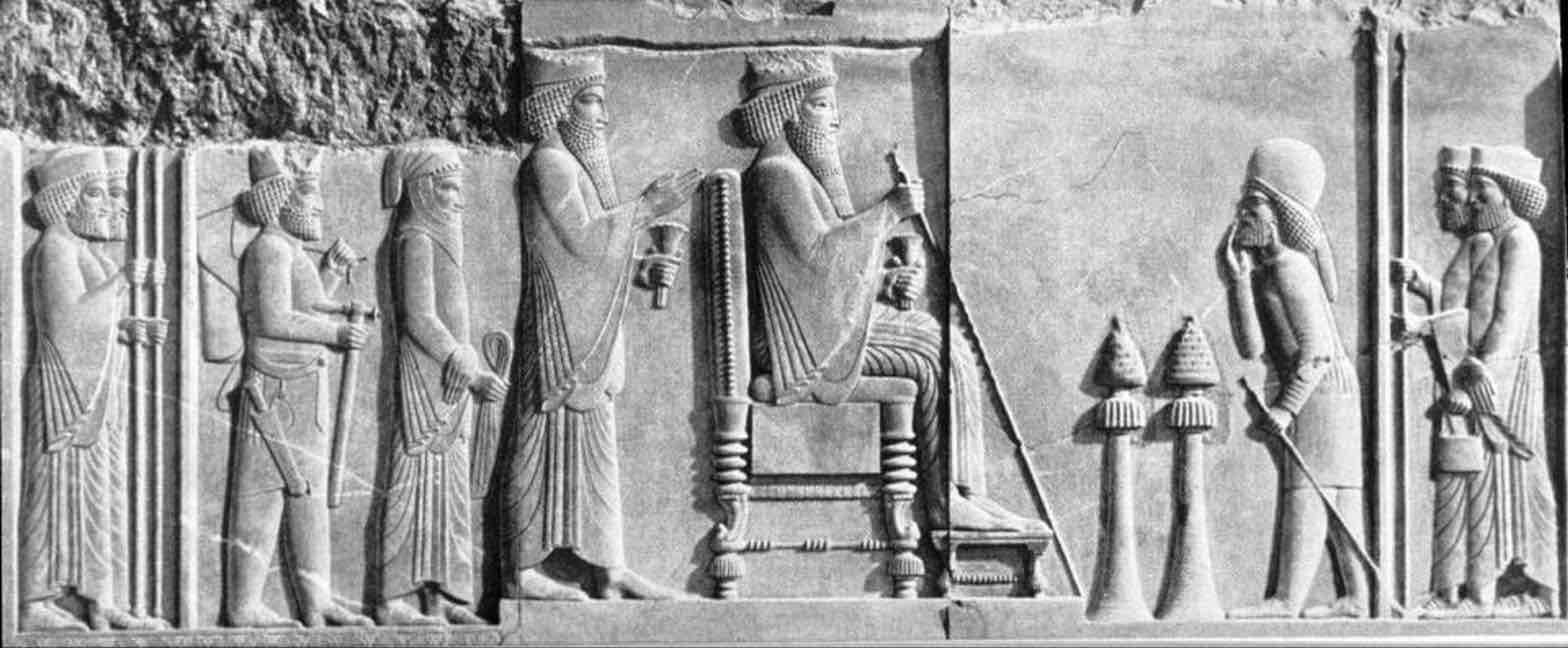
Persepolis audience relief
1st half of 6th century, Persepolis Iran
Dark limestone with metallic finish that turns almost black
All the tribute bearer reliefs culminate at this relief of the King seated on throne ready to receive the tributes
He is larger than the other figures, but also on small platform (physical superiority)
Feet not on the ground but resting on a stool = importance (!)
Crown prince the only other on the platform (holds lotus - symbol of eternity)
Both have large beards (longest) and all have schematic hair (beaded)
And Magian standing behind the platform (with soft turban - padam)
And then soldier with double-axe and arrow, + Persian dagger
Facing Darius are two incense-bruners and then a man sending a kiss (hand placed upon his lips)
Persian who brings the different delegates
Remember that all would be covered (and appeared under gazebo)
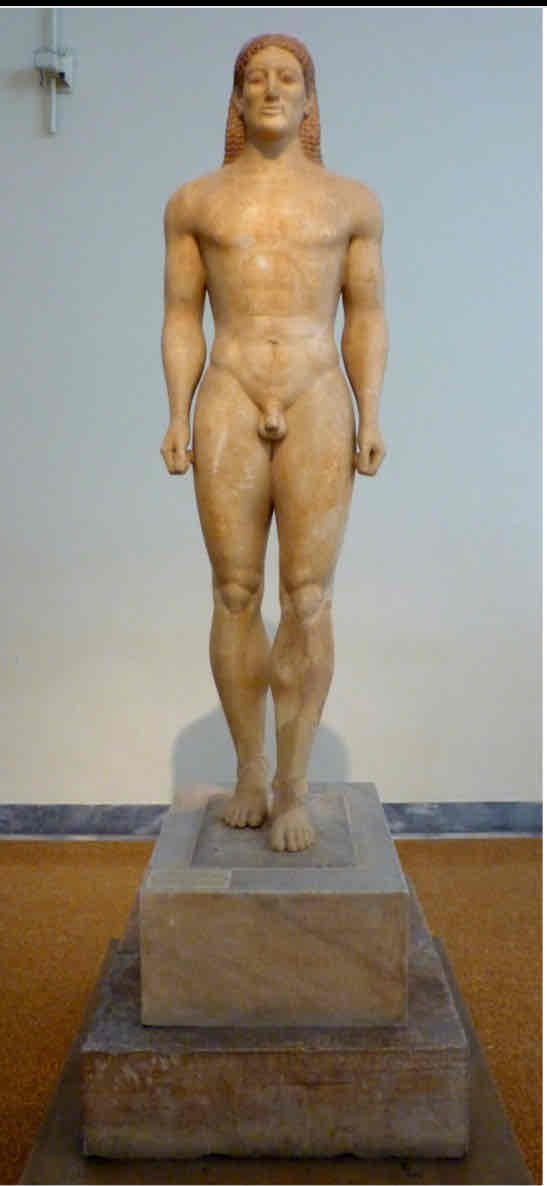
Kroisos’ kouros
530BC, Anavyssos, Attica
6th century had only two generic representations of aristocrats (even stelai had same poses)
Initially inspired by Egyptian figures (but these were more like reliefs and were clothed
Very schematic styling until naturalism of the late 6th and then even more in early classical
Kroisos as warrior (potentially had small cap on head that would protect head from helmet)
Almond-shaped eyes and Archaic smile (meant to convey life)
Had painted pubic hair in ‘fish-tail’ = took care of oneself = wealthy
But more natural than the new-york kouros (V-shape has become fleshier hips)
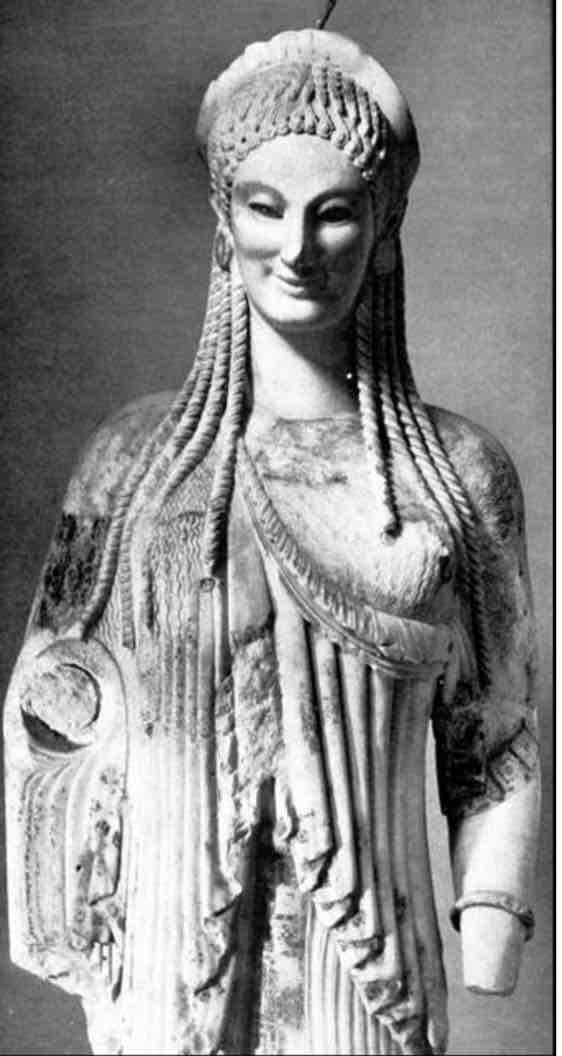
Acropolis kore 682
500BC, Acropolis, MofAc
Perserschutt - votive for Athene that survived the destruction of the Acropolis and were buried (thus can be dated to pre-480)
Typical heavily stylised kore with layers of different dress (Ionian chiton & skirt with himation over top - viewed as luxurious and ‘oriental’)
Has head-piece (stephane) & earrings
Hair is beaded and comes in braids down each side (some knowledge of gravity in how the braids fall into crevice between arms and breasts)
Very frontal (no attempt to show a pose or limbs moving) and has Archaic smile like Kroisos
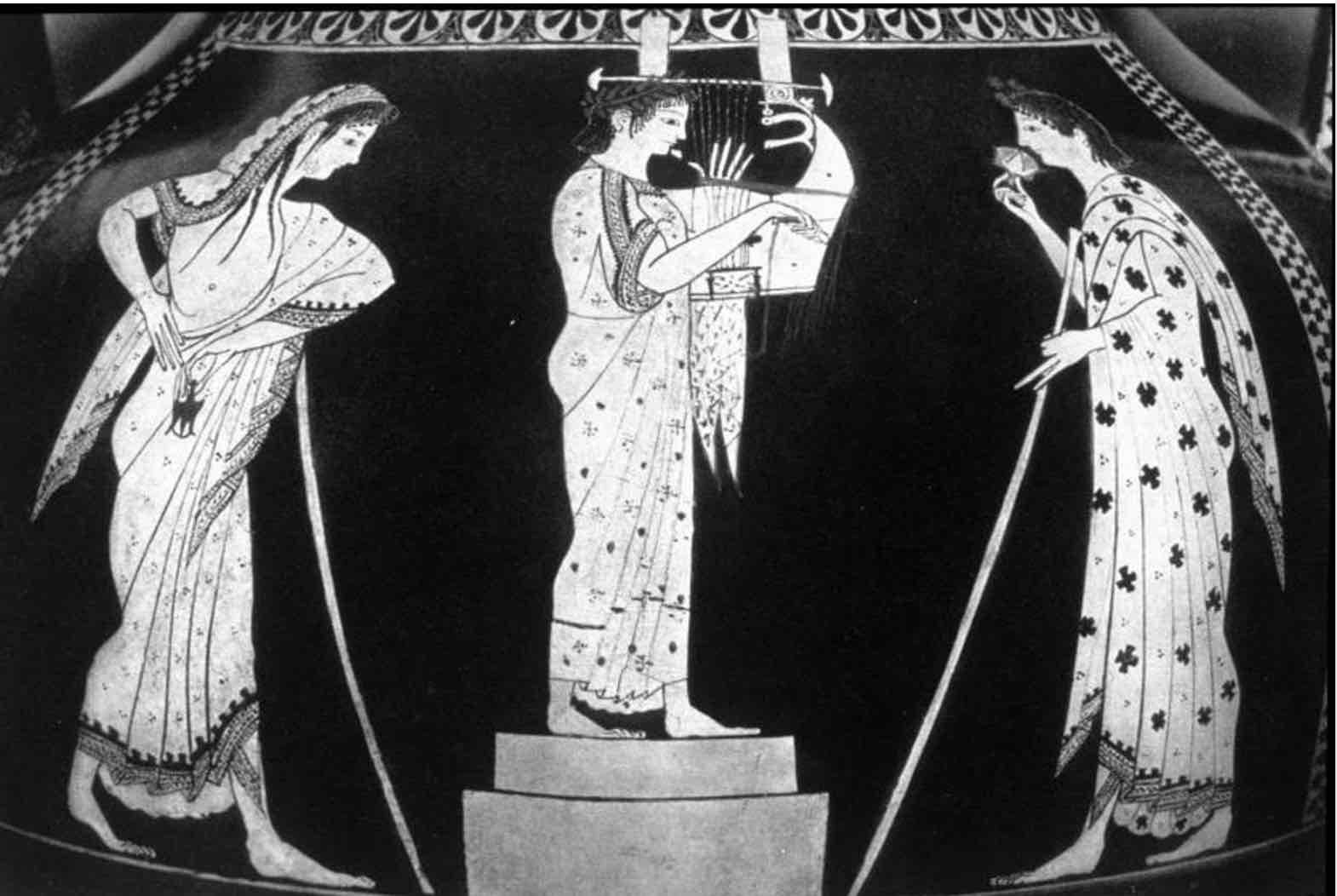
Andokides performers amphora
c. 520, Louvre
Pot showing kitharode - performance of kithara surrounded by two male figures (one holding flower, the other smelling)
Covered head to toe in robes which are patterned (compare to contemporary korai which dresses was populated with symbols or images)
+ see attempt to show the folds in the fabric even in paint
Man on left has hair in three braids that fall over shoulder (shows the care in appearance)
All meant to convey their wealth = time to engage in music, patterns show care in the material and thus wealth
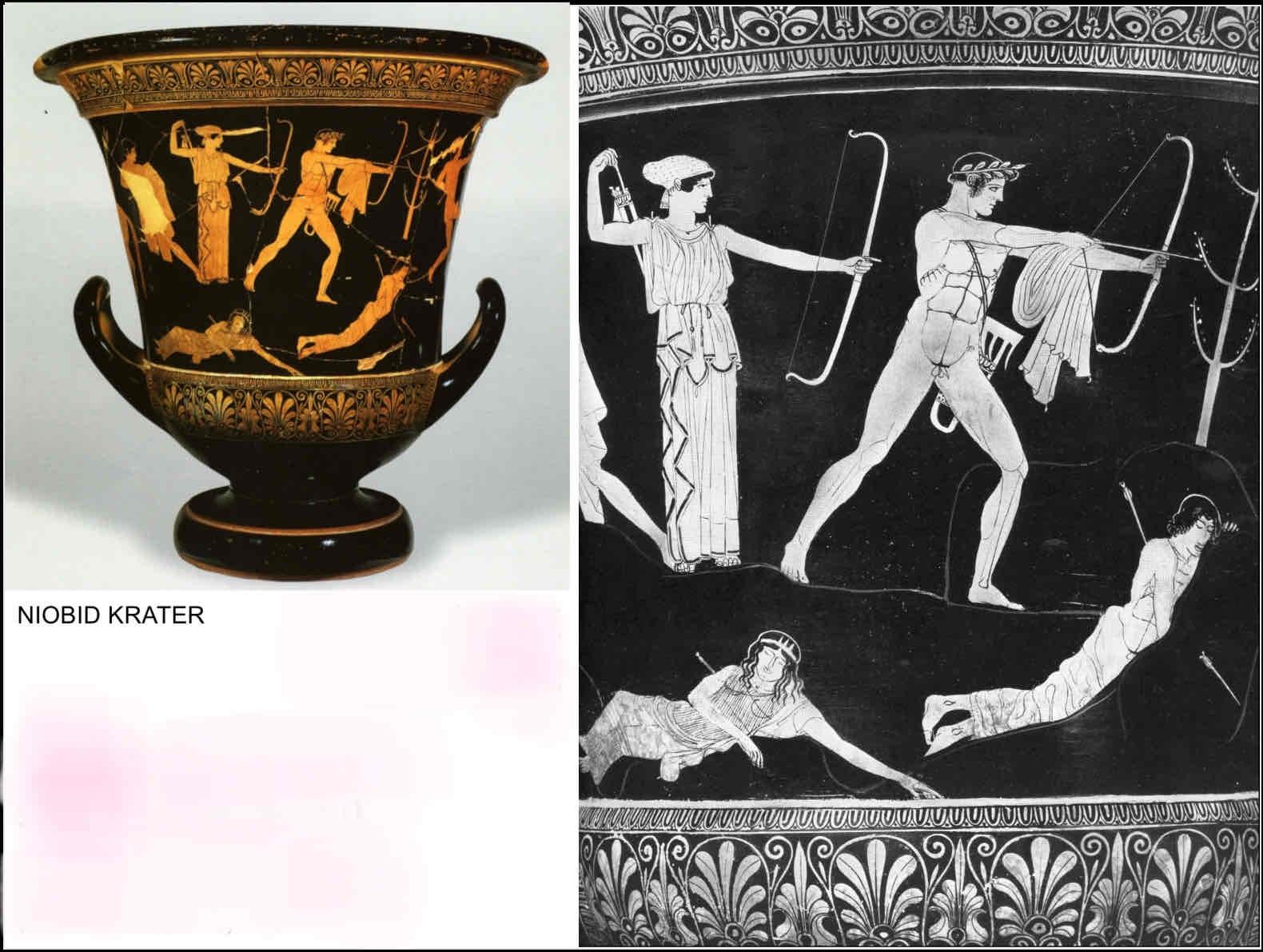
Louvre Niobid krater
c. 460BC, Louvre
Shift in how bodies are represented (Post-Persian!)
Apollo is represented here nude in dynamic pose (not stationary!) as stretches with his bow to attack one of Niobe’s sons
But still quite static (muscles don’t respond to action)
His musculature is shown with sharp black lines (idealising body form)
Short hair and severe expression (comp to Archaic smile)
Himation only dress, thrown over one arm
Artemis is also wearing peplos (could be an expression of female costume become more modest and less patterned = separation from the Near Eastern aestheticising)
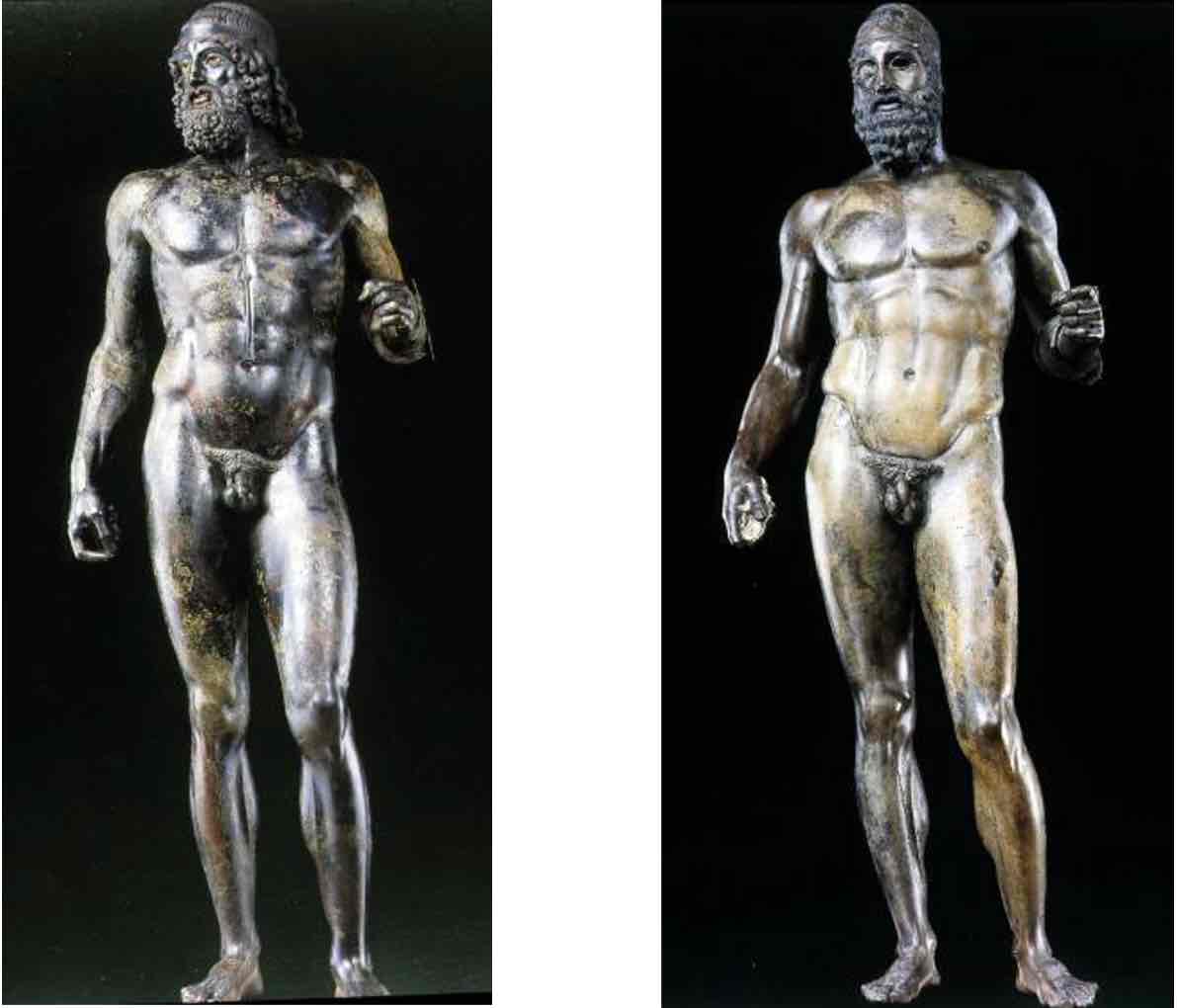
Riace bronzes
c. 460BC, Reggio Calabria
2 original bronzes found in the Med seas = representative of the new post-Persian war severe period (originally holding weapons as most do - shield on left, spear in right)
No longer static and frontal, but now in unique contraposto pose with hip tilted up and foot outwards facing = breaking the archaic symmetry
Also shows naturalism as walking pose now has some impact on the anatomy
Combination of striking naturalism & unrealistic idealism
Also shows a level of characterisation (not seen in kouroi) in which the two figures are distinguished (one is hero / divine and the other is more contemporary & for sure mortal)
Riace B’s hip also tilts out further
B could have been wearing a helmet & A a garland
Also lack of archaic smile, and use of different, new materials like glass paste and silver teeth (+ would have originally been polished to a tan bronze colour = trying to be an imitation of man)
Lead dowels installed in their feet = originally mounted on a base = part of statue group?
Debate about who they are meant to represent (idealism! So hard to tell) & if actual Severe or Hellenistic recreations
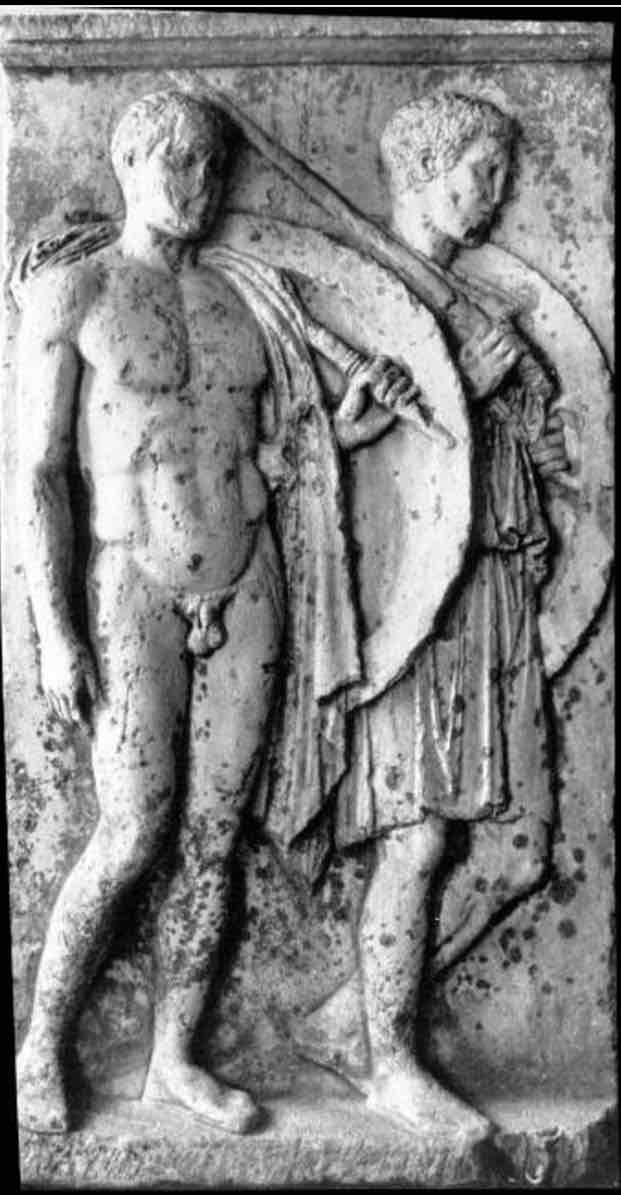
Salamis stele
c. 420BC, Salamis, Athens
Stele - funerary relief (cenotaph - empty grave purely for memorialisation)
Chairedemos & Lykeas - two casualities in the Peloponnesian war
A Lykeas appears on casuality list from 410BC (as a triarchon! But presented as a hoplite = rhetoric of the hoplite)
Chairademos is given all attributes of the Classical era heroic warrior (muscular torso with well-defined abdominal and chest muscles)
= glorification of the warrior (seen in the public and the private sphere)
Shows layering of figures as man in foreground and another in background
Foreground is nude, showing the contraposto post through the tip of the left hip and the gliding right leg
Foreground also has cloak accentuating his figure (not practical)
Other has chiton
Both have spears & large shields = hoplite armour
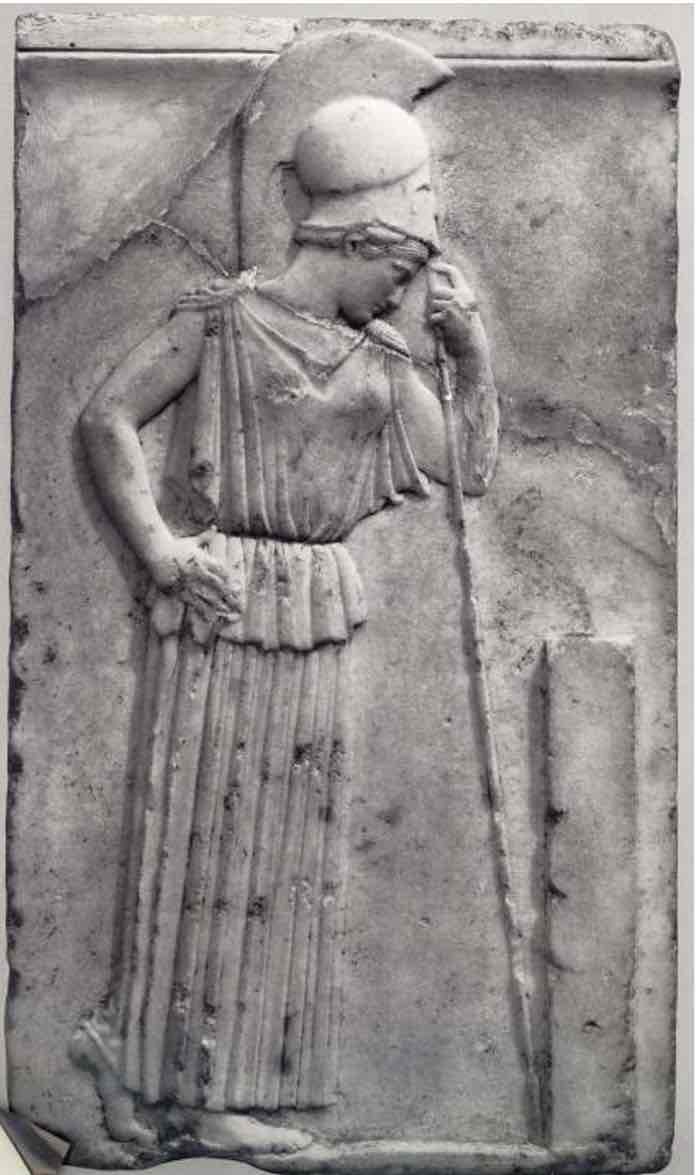
Mourning Athene stele
c. 460BC, Acropolis, MofA
Votive stele - in public?
Wearing Athene iconography = Corinthian helmet and old-fashioned peplos
Holds her spear to her head - is this a sign of mourning?
Many have extrapolated and seen the block she appears to look at as a stele with list of names of the war-dead
But no clear evidence that this pose is even mourning (anachronistic?) - some see it as exhausted, and others imbue no emotion
Gestures in ancient world different to now (bowed head is usually for god looking down on worshippers!)
Very simple folds to her dress (but not entirely vertical but follow the lines of her body)
Thick, body-concealing Attic peplos
Breasts only slightly revealed and almost volute style to the skirt of dress = caryatids on Erechtheion
Also has Corinthian helmet = glory of the past (+ quick signal as Athene)
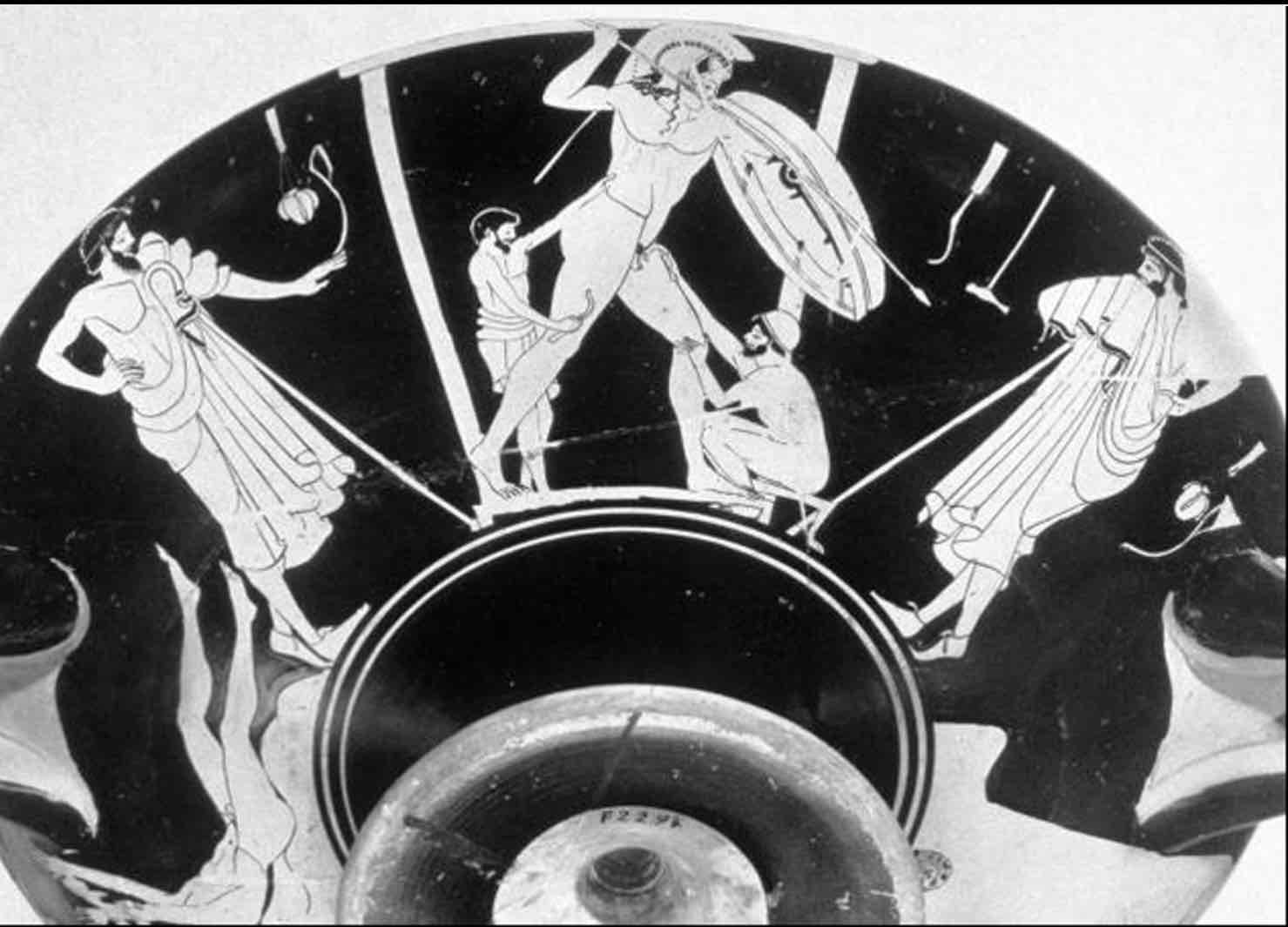
Berlin Foundry cup
Early 5th c. , Berlin
Painting on the outside of the kylix by the Foundry painter (this is his name piece and has others like it)
Important for depictions of the everyday
Tondo shows Hephaestus making the divine armour for Achilles!
Actual depictions - metal workshops in the Kerameikos
Shows an interest in the process of sculpting, not only finished project
Bronze sculpture being worked on, stands in wooden scaffolding
Sculpture as idealised hero - strong strike forward, holding spear and shield with helmet revealing long hair tumbling down shoulders (but quite archaic looking, with large buttocks and thigh, and unnaturalistic twist of the body)
Comp to Riace A
Wears helmet, but cheek-guards folded upwards to depict face more clearly
Hammer & scraper lie nearby
Two men stand on each side watching = who are they? Buyers? Or passers-byer as have strigil and aryballos in background
Other side of Foundry has a much more unfinished figure
Lying on the ground on its back with no head (head has hair cut close to head = athlete?)
Portrayal of the two different types of male ideal at the time
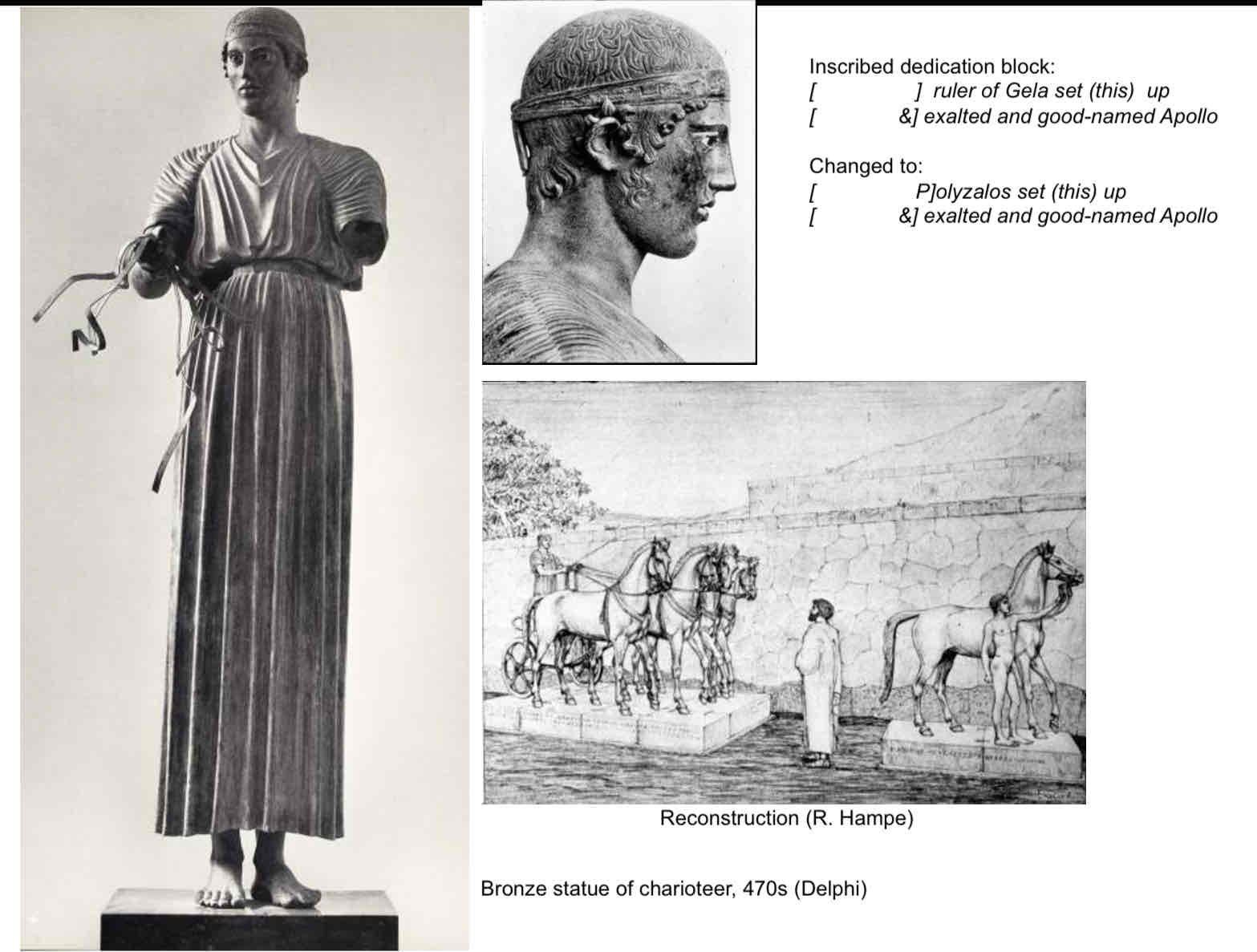
Delphi charioteer
470s BC, Delphi
Excavated overlooking temple of Apollo
+ inscribed block with two dedications (original = ruler of Gela, but then cut back for second dedication = Polyzalos, tyrant - for Pythian games)
Basic form = charioteer in chariot, led by at least 4 horses attended by groom (characteristic charioteer costume with long chiton to ankles)
Portrayed during victory lap? (calmness suggests not during the race)
Some fragments of horses (more finely worked than charioteer himself = paid-up lacky contrasted to horses as star of show in chariot races)
Head - severe look, pouty lips, cap of short hair close to scalp (= cold-work of curls), eyes of glass-paste & semi-precious stones, eyelashes of copper & silver teeth inside mouth
Soft side-curls = teenager (charioteers chosen for height and lightness)
Wears the xystin (fastened by wide belt) - odd for time period as many would have appeared nude
Feet - finely observed with veins and bones clearly shown
Contrast to marble Motya charioteer from similar time (470-60BC) with dynamic pose (weight shifted, arm is akimbo to hip that is pushed out, right leg pushed forward = is the aristocrat himself?)

Motya charioteer
c. 460BC, Motya, Mozia (Motya was Phoenician colony = could have stolen the statue from elsewhere on Sicily)
Coarse-grained white marble with cloudy grey vertical streaking (would have been coloured)
5’11
Wearing a chiton specifically for riding (xystis) = characterised as a charioteer
Has two holes on the belt where reins would be fastened (means that they couldn’t be pulled from hand, but also that he would go flying with the chariot if a crash)
But different to Delphi charioteer!
Fabric clings to the body, accentuating the unique pose (as well as his genitalia that would usually be revealed)
Left hip shifts up as weight-bearing leg (right glides out)
Left hand on hip to emphasise
Archaic snail-curls on brow = aristocrat!
Potentially wearing a headdress (bronze pins inserted into surface of head above row of snailcurls)
Face less plump and fleshy than other statues of the time eg. Blonde boy & Olympian Apollo
Head at different angle - looking to left (+ tilts downward slightly)
Marble instead of bronze like Delphi
Could be either Nikomachos or Thrasyboulos
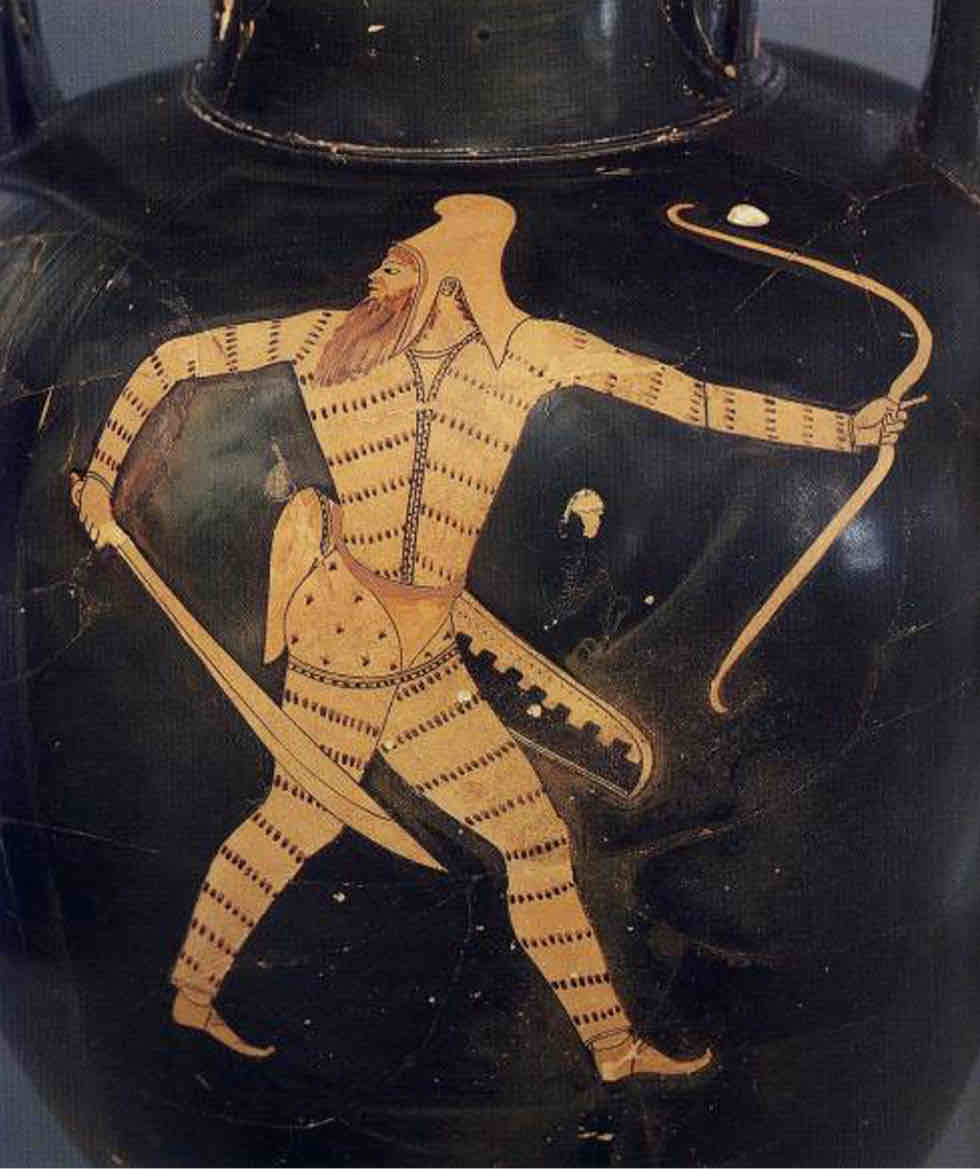
Persian bowman, Berlin painter amphora
c. 480BC, Getty museum
Attic red-figure terracotta storage vase
Greek portrayal of Persian warrior
Wearing skin-tight jumpsuit = opposite to Greek male ideals
Body fully covered (cont. to heroic nudity) and also patterned (aesthetic over practicality) = Athenian fantasy of the ‘barbarian’
Orange-painted loin-cloth attached to which is a bow case / quiver (North & East of Greece)
Holds bow out in front = priority of the bow as weapon as choice (but no arrows = failure at even own standard)
Also has very long sword (machaira) which Aesch comments on in its impracticality in battle (but could be symbol of courage?)
Has mitra (upon head that turns back potentially to watch his attacker) & pointed shoes
Full ginger beard and moustache and and orange hair peeks out of cap = non-Greek (+ snub nose)
Contrast to the Greek hoplite on the opposing side (Corinthian helmet, spear uplifted and large shield = all practical and ready for action)
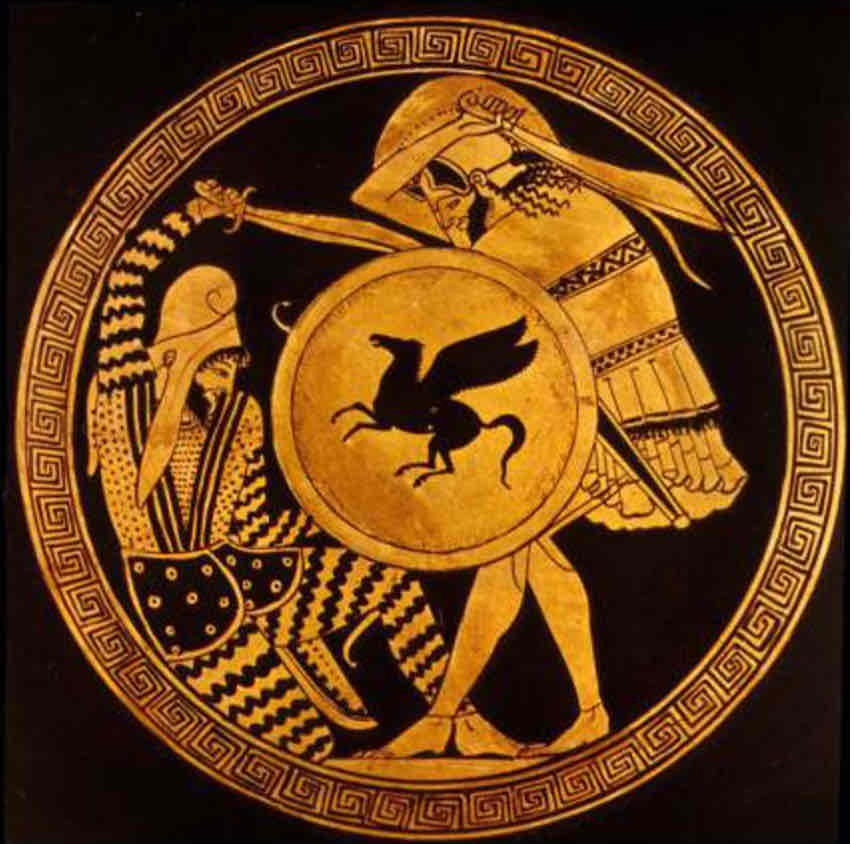
Edinburgh cup, Triptomelos painter
c. 480BC, Edinburgh
Tondo of kylix - portrayal of Greek victory over Persian (outside scene is battle also)
Greek takes up most space on the circle (and feet overlapped)
Wearing greaves, cuirass of stiffened linen over short robe with many folds, holds up kopis sword, used for slashing
The Persian (with Phrygian cap and stripped jumpsuit) is pressed up to side of the painted bottom of cup
Is in attempt to fight back, but in vain
Has bow but it is hidden behind the Greek’s round shield (has Pegasus = symbol of peace over chaos as killed Chimera)
Wearing typical mitra and his gorytos is visible (but also wields a kopis sword)
Shows the submissive and beaten Persian
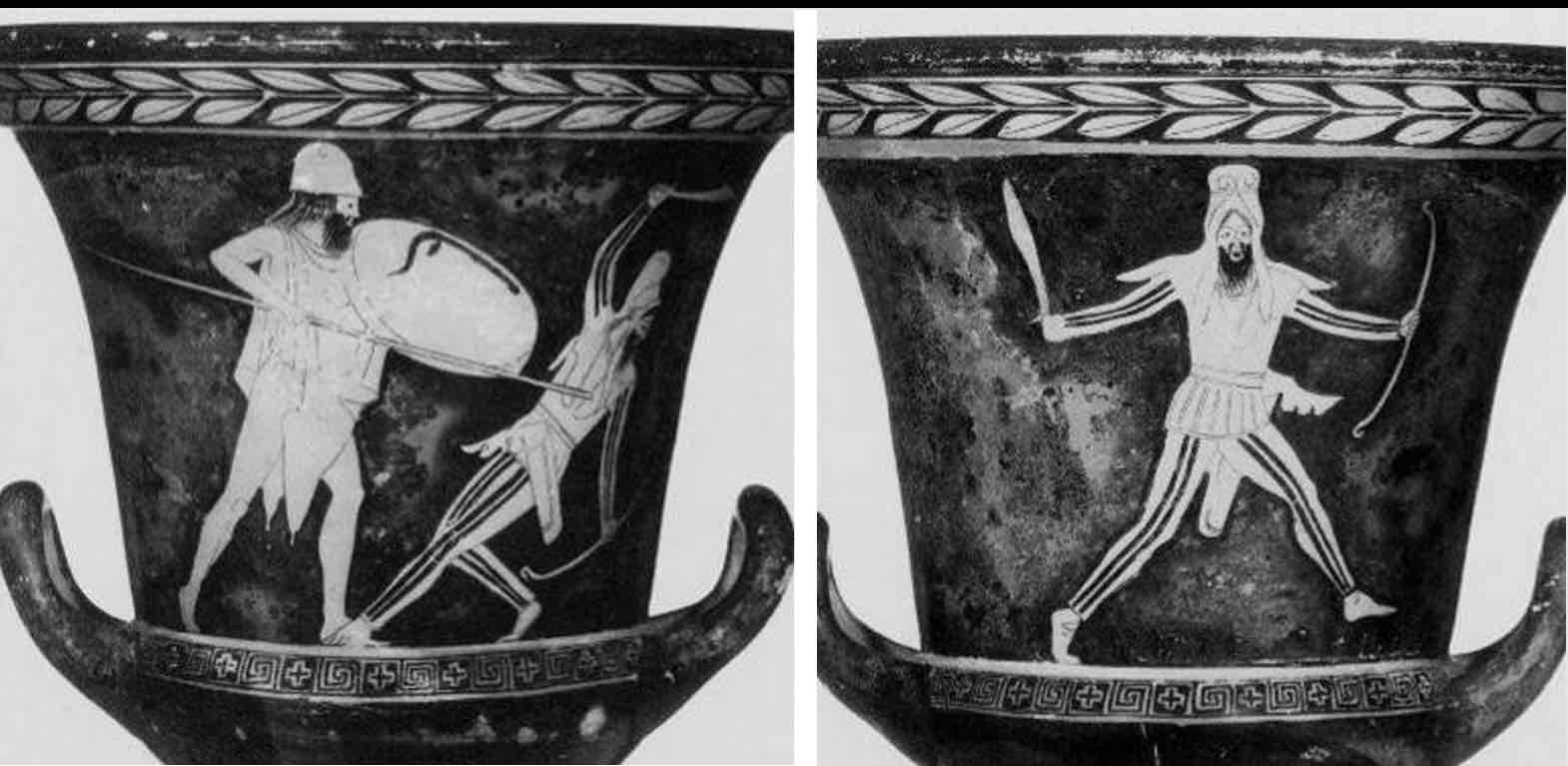
Fleeing Persian, Basel krater
c. 450BC, Basel (Calyx krater)
Portrayal of fleeing Persian & defeated Persian
Side B Persian is being hit by the Greek’s spear and thus leans back (unnaturally)
Has on the patterned jumpsuit (here with vertical lines)
And Phrygian cap & bow (all indicators of Persian)
In contrast to off-balance pose of Persian, Greek is very fixed (assured)
Has his long spear and large shield
Only wearing a cloak which reveals legs (tactical nudity = only hoplite gear and perhaps a cloak)
Has long hair and long, seemingy wavy beard = mature man
Side A has Persian in flight, as he faces forward to the audience (= terror, like Eurymedon jug)
Legs stand far apart, both arms to the side in frontal view
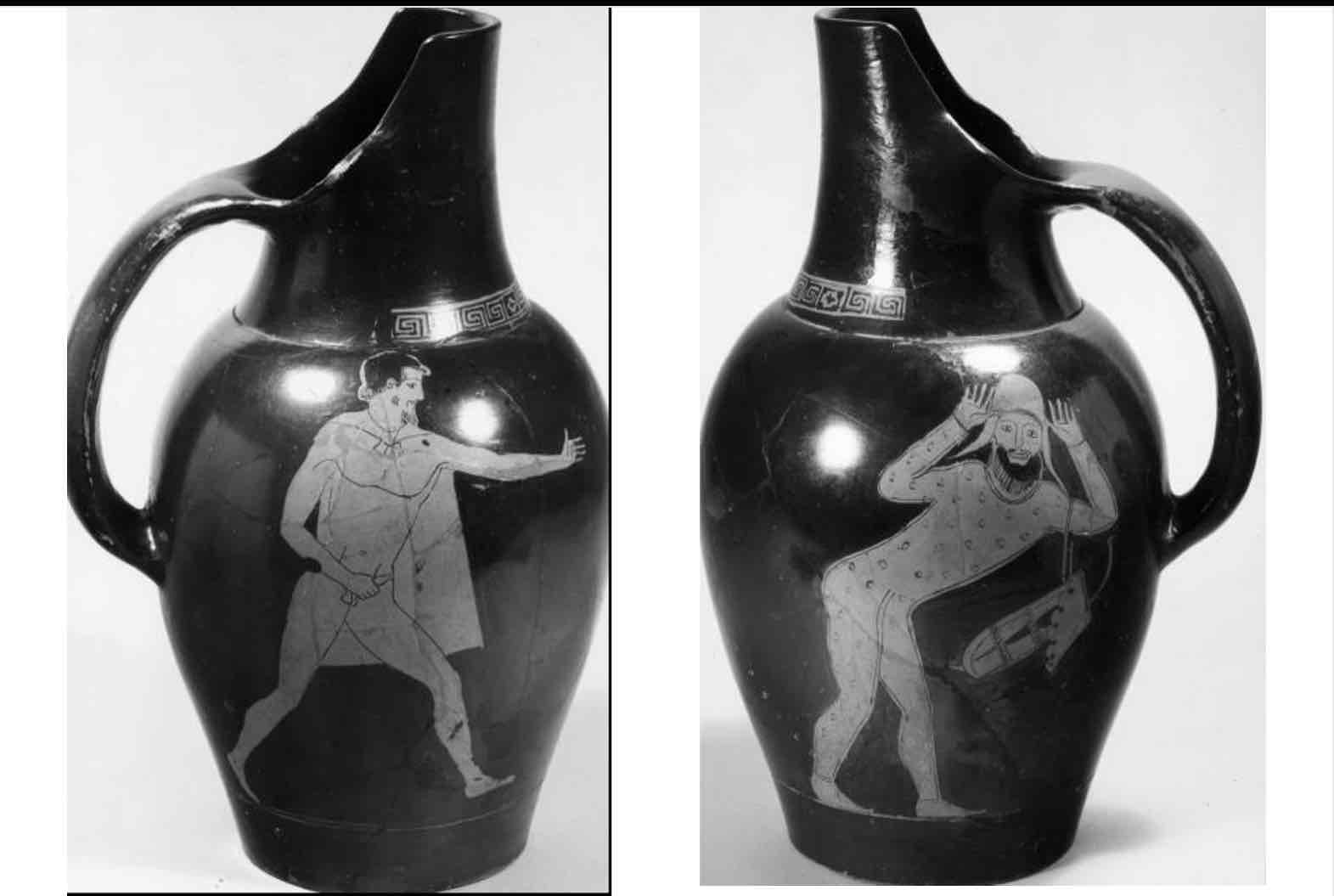
Eurymedon jug (Hamburg)
c. 460BC, Hamburg
Oinochoe with single handle (terracotta = different materials for portrayal & decoration)
Nude Greek hoplite runs forth as he holds his erect phallus
Nude Greek has square Scythian cloak (+ scraggly sideburns & little goatee & unkempt hair = non-elite
Many have seen this as the man running to sexually assault the Persian who leans over and holds his hands to his head
‘Persian’ looks at observer = in danger
Wearing typical patterned jump-suit, has quiver (Scythian-style gorytos) & Phrygian cap & bushy beard (= not a youth, so shouldn’t be an eromenos)
Words out of Greek mouth - I am Eurymedon, but you stand over
(Battle between Greeks and Persians at river Eurymedon in western Anatolia)
Sexuality as means of navigating power (even in military warfare)
Sexually submissive = weak (just like femininity is used to weaken & demean the foreign enemy)
Some have seen this not as a scene of sexual assault, but as a mock epic of sorts (style of the ‘Greek’ and ‘Persian’ mens dress could be Scythian - problematises the simple sexual reading)
BUT is this simply revealing of the Greek inability to distuinguish the ‘foreign’
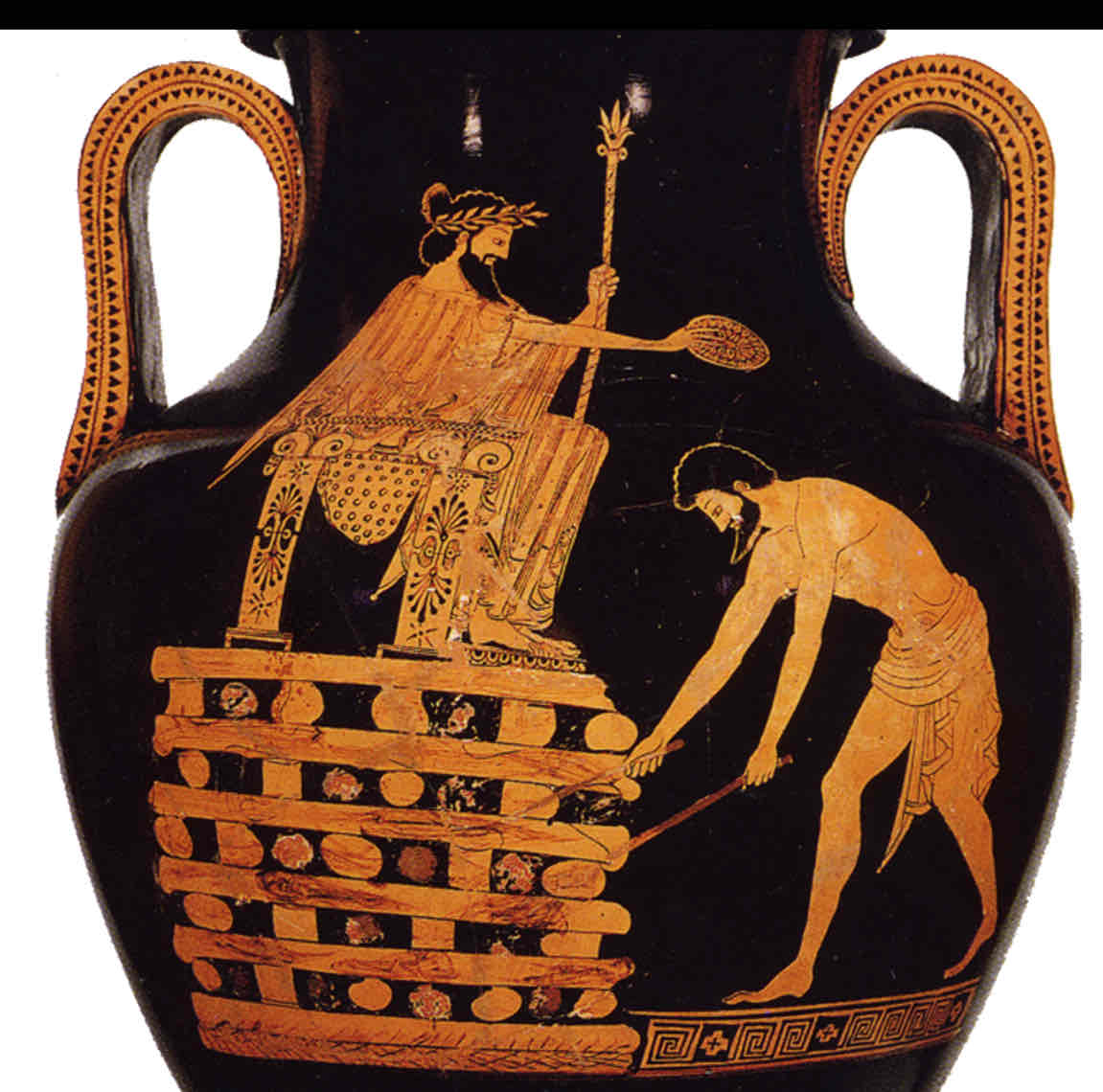
Croesus’ amphora
500-480BC, Louvre
Greek portrayal of the Croesus tale (on side of belly amphora)
Quasi-mythological figure, but his city of Sardis was real!
Which fell to Cyrus in 545BC
Mounted pyre as punishment, but Apollo’s rain extinguished the flames (was pardoned by Cyrus and then became chief advisor to Cyrus)
Closely connected to Greek religion (See Herod on his votives & oracles at Delphi) so interesting he still fell
Sits on elaborate throne with leopard skin pelt, pouring libation from phiale & holding twisted sceptre (throne has posts decorated with Ionic capitals)
Feet supported by foot-rest decorated with ovums
Slave lighting pyre with 2 torches as he weeps (clear tear drop)
Croesus garlanded with laurel
This myth is also narrated by Herod & Bacchylides (used as comparison to successful athlete)
But different portrayal of Croesus than Herodotus
Herodotus has Cyrus put him on, but in Bacchylides it is Croesus’ own decision to take own life as here (saved by Zeus!)
Other side of amphora has Theseus and Peirithoos capturing the Amazon queen, Antiope (contrast of morals?)
Precursor to failed Persian invasion, where Amazons invaed Attica and are seen off by Theseus who captures Antiope
Defeat of an ‘Eastern’ figure?
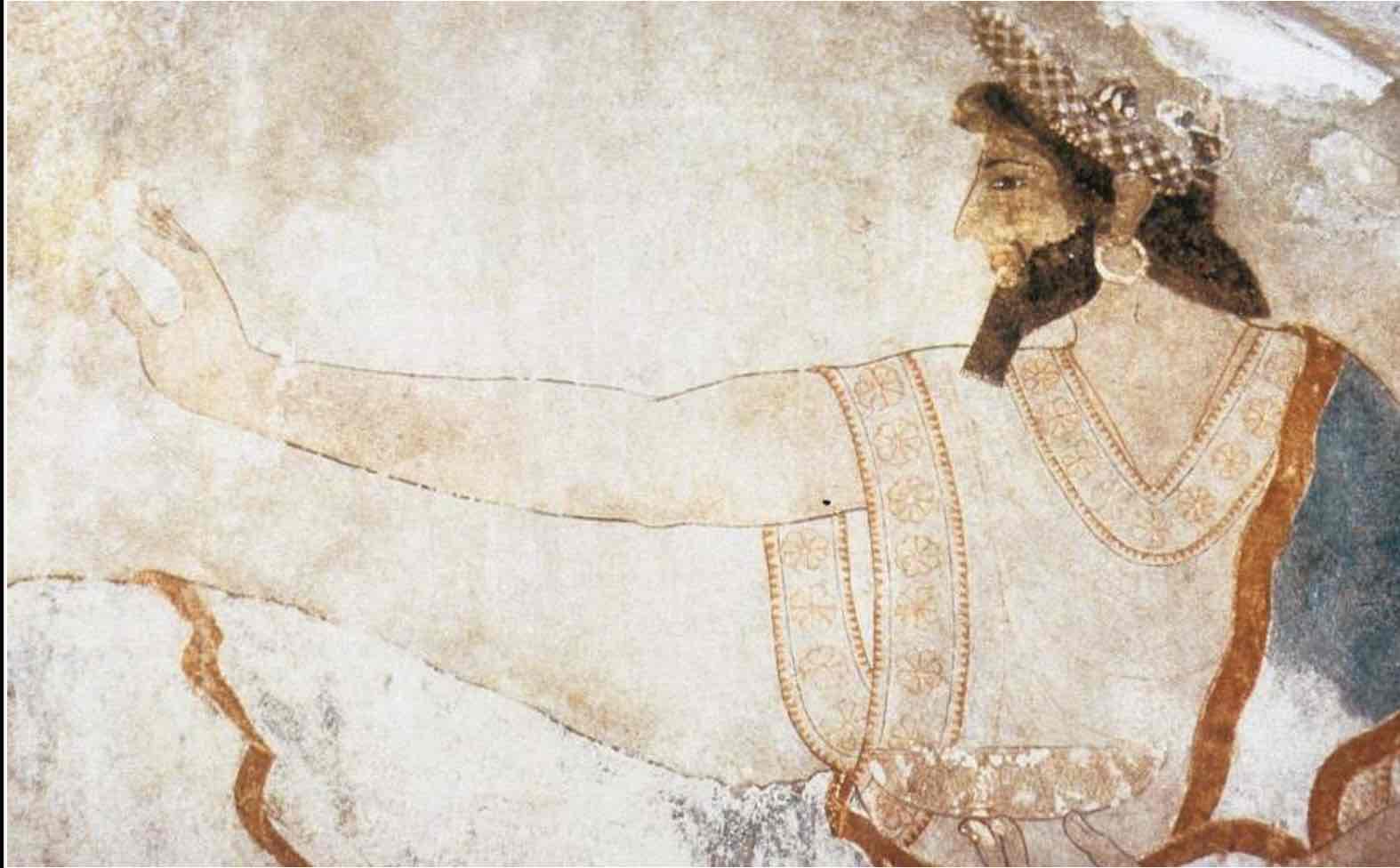
Karaburun tomb painting
c. 470BC, Karaburun, Lycia (tumulus most likely built in life-time)
Fresco found in tomb (use of colours!)
Face in profile but eyes frontal in archaic style (nose is straigh line from forehead)
In local Anatolian dress (off-white tunic with bright floral decorations around neckline and large open sleeves, with rich blue cloak hemmed with rid over left shoulder)
But beard ends with square (Darius has similar visual portrayals)
+ diadem and earrings (+ lion-head bracelets)
Wearing a Persian jacket over his shoulder
But dignatary is reclining in very Greek manner
Has a female figure behind him (offeringalabastron) and summons two slaves ahead in Persian style (+ one holding wine jar with griffin handles & the other with fan with ram terminal = Persian)
Balances lobed phiale on his fingertips (Xenophon describes seeing Cyrus hold his cup with three fingers = Achaemenid way)
Other sides:
Procession
Battle-scene of Persian warrior on horseback succeeding over a Greek hoplite (has large shield, Corinthian helmet and pot. greaves)
The other side to the Greek vases!
Shows local interest as well as a mixing of Aegean and Achaemenid style
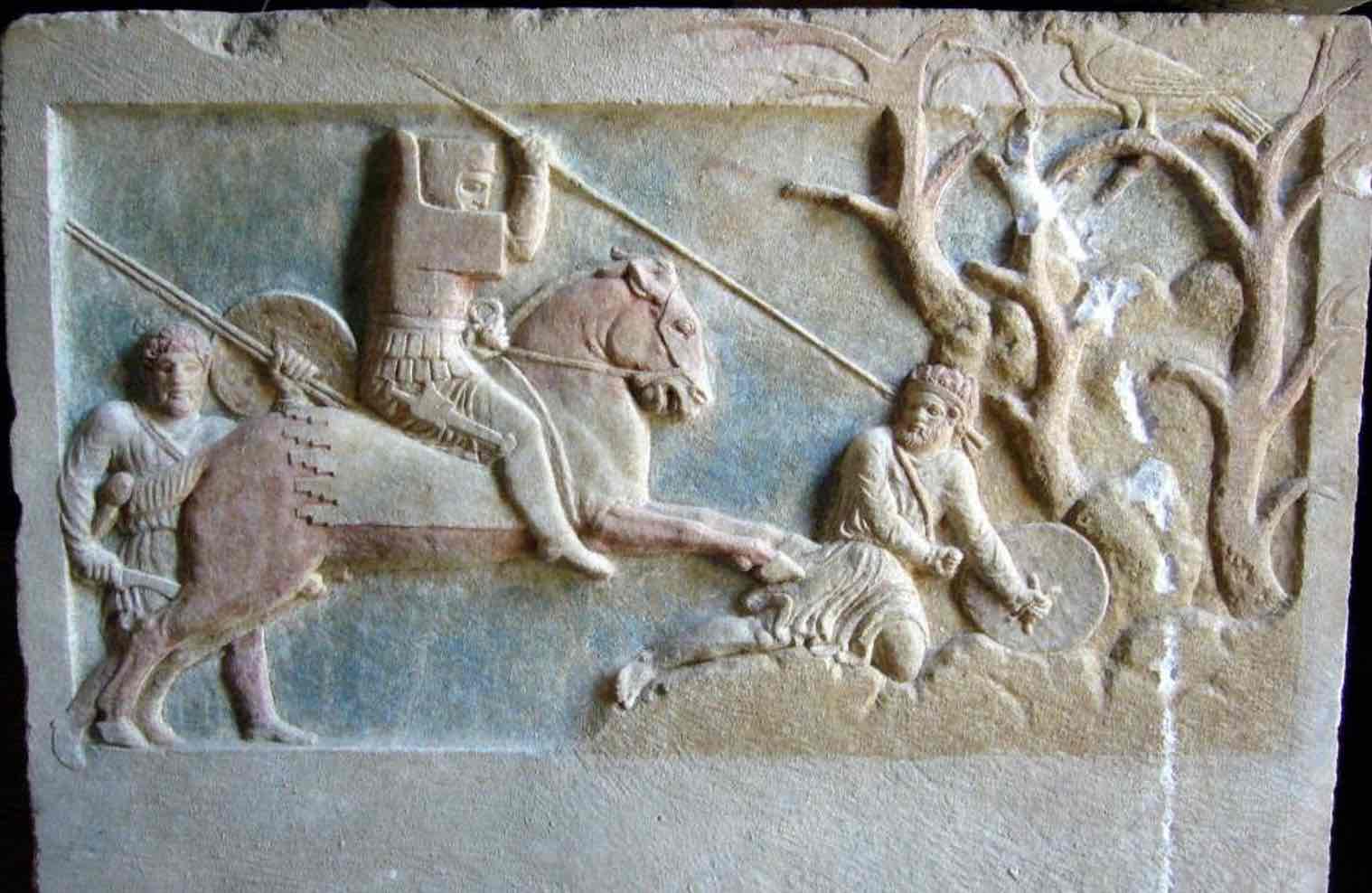
çan sarcophagus
c. 400BC, Cannakale Museum
Occupant was most likely member of the Persian elite / locla Anatolian dynast (sarcophagus found in tumulus)
Shows a man on horseback rearing at a boar that is being attacked by two hunting dogs
Odd lack of any background (only one tree) = Macedonian style for tombs
Hunting was a sign of royalty
On short side, see a ruler spearing what many have seen as a Greek
Rider has long spear which impales the eye of the ‘Greek’ (spears usually shown brandished behind the head = noval pose)
Also noval outfit - long-sleeved pink tunic under cuirass with large shoulder pieces extending to elbow, with vertical projection up behind his helmet
Also has leather helmet with flat top, covering back and sides of head
Not shown in any other Lycian tombs (but does on greco-persian gem stones
The attendant may be Greek mercenary (has long-sleeved white tunic, red trousers and two spears with small shield + sword with concave section = machaira
‘Greek’ wearing long-sleeved dress that comes to knees, that ripples with frequent folds
Attempting (but too late) to pull sword from his sheath, just a singular shield (not even using to protect himself from the horse-rider, just accepting his fate as he collapses to the ground before the trees)
Others have argued that they are both Mysian, but the difference in dress is meant to convey opposing alliances = Achaemenid and local concerns